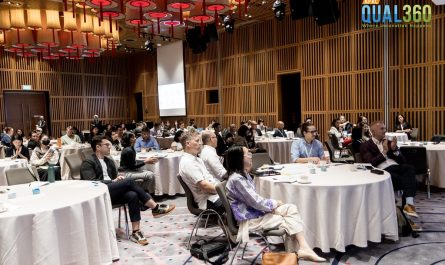The relationship between language and culture
The relationship between language and culture provides very interesting insights about cultural development and social trends. It enables us to focus on a research participant’s current situation, as well as helping us to interpret and further understand the emotional connection between past experiences and current events. Language is a part of culture, and the enrichment and development of culture also benefits from language.
As the American linguist Edward Sapir emphasised, there is always something behind language. Language cannot exist without culture. In a way, culture is the sum of a person’s habits and beliefs inherited from society, that helps determine a way to organise our lives. Language also has the effect of facilitating communication and cooperation between people. Therefore, language is not only a reflection of ‘mental pattern’ (that is, a psychological activity), but also a presentation of different cultures.
Creating new phrases in Chinese society
In our daily lives and interviewing settings, our attention is often drawn to the way Chinese people use and create new phrases, as it shows their creative way of thinking and their interpretation of the things around them. For example, the term ‘內卷’ (pronounced Nei Juan) literally translate to ‘internally drawn into’. It is often used to describe irrational internal competition or “involuntary” competition. This was initially used to describe a reluctantly competitive ambiance in Chinese schools (i.e., primary, secondary schools, and universities), but its use was extended to the workplace and highlighted the fact that people were ‘forced’ into making more efforts to compete for limited resources. This was also the result of the declining ‘income-effort ratio’, that caused stress and discontent.
‘內卷’ highlights the effect of social pressure, even though one is unwilling to participate in very competitive environment. This helps us a better understand the pressures that our participants experience and provides a very nice analogy of their sense of unwillingness and helplessness towards a situation. It adds another level of understanding of their way of living and further, another reason why they want to have less hassle with brands and products.
Promoting individualism
Another term we often hear in our interviews is 社死 (pronounced She Si), which literally translates to ‘social death’. It’s used to describe a scenario where a person, who has made a fool of themselves in front of others, feels extremely embarrassed and just wants to find a crack in the ground to hide in. It is interesting to note that people like to see themselves as independent thinkers and unique individuals, however, the reality is that people’s sense of integration and need for belonging are rooted in their brain and physiological structure. We want to fit in, we want to be liked and we want to be accepted by others. This is particularly true in Chinese society, where great emphasis is placed on relations. In social situations, this powerful driving force often drives people to observe others and find a mutual code of conduct that is socially acceptable. In a way, it can be quite difficult for Chinese people to be individualists. Though they may be attracted by the idea of a brand that promotes individualism, they often find it hard to integrate it into their daily lives.
A term frequently used among young people
Having said this, the creativity of the modern Chinese language often amazes me. Given the stressful living circumstances, people still manage to come up with some interesting words to counter the situation. 躺平 (pronounced as Tang Ping) literally translates to ‘lay flat’. It describes a state of mind that is chilled and not eager for success. Perhaps some people perceive ‘lying down’ as a way of giving up, but it can also be interpreted as the most passive way to rebel. What we noticed in our research is that this term is more frequently used among young people, than those who are married and have a family. When young people use ‘lie down’ to describe their state of mind, it seems that they have chosen a way of living that is different to the mainstream of working overtime, working for promotion, making money, and buying a house or car. Instead of screaming out their differences, they have chosen a subtle way that is effective and suitable for their cultural upbringing.
Creativity is embedded in culture and communication. We may try to come up with a new research method to gain a new perspective, however, sometimes all we need to do is to carefully listen to the words people use. These popular terms not only help us to understand the person sitting in front of us, but also provides some amazing insights about social-cultural development that is very helpful in brand building and product development. So, what we need to do is pay close attention and listen.
If you enjoyed this article, check out more on qualitative research at: https://qual360.com/
Additionally, join our global community of researchers and qualitative leaders at the upcoming in-person and virtual events:
Insights Extravaganza EU 2021 on 20 – 21 October, Berlin & Virtual
Insights Extravaganza APAC 2021 on 10 – 11 November, Virtual
Sign up to receive our email alerts for news, updates and special offers!










 by
by 



A very superficial article on currently trendy terms that have been defined, redefined and debated to death in Chinese media in the last year(s). People (consumers) simply reacted to media discussions, took those terms to integrate into their own articulation portfolio as they frequently do, to then echo and align with the mainstream conversation. This doesn’t equate behavior changes, the perceptions and behavior the author describes has been observed with every single generation and ‘tribe’ in China in the last few decades and is nothing new at all.
A very superficial article on currently trendy terms that have been defined, redefined and debated to death in Chinese media in the last year(s). People (consumers) simply reacted to media discussions, took those terms to integrate into their own articulation portfolio as they frequently do, to then echo and align with the mainstream conversation. This doesn’t equate behavior changes, the perceptions and behavior the author describes has been observed with every single generation and ‘tribe’ in China in the last few decades and is nothing new at all.